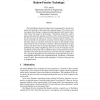Free Online Productivity Tools
i2Speak
i2Symbol
i2OCR
iTex2Img
iWeb2Print
iWeb2Shot
i2Type
iPdf2Split
iPdf2Merge
i2Bopomofo
i2Arabic
i2Style
i2Image
i2PDF
iLatex2Rtf
Sci2ools
BMVC
2000
2000
Statistical Properties of the Hybrid Radon-Fourier Technique
The hybrid Radon-Fourier technique has been proposed for the discrimination and tracking of deforming and compound targets. The current work investigates the technique's unique statistical properties which make it inherently robust with respect to performance. The Radon transform is used to generate the geometric signature waveform of the convex hull of the target, this then becomes the input to the Fourier Transform and the Fourier coefficients determine the parameters associated with the shape and motion of the target. Because, in general, relatively few points on the boundary of the object define the convex hull they will follow a Poisson distribution. In addition, for each point in the set of points defining the convex hull, there is a high probability that another neighboring point on or near the boundary may be substituted for that point with no significant effect on the performance of the algorithm. This means that the data may be extremely sparsely sampled without a signi...
BMVC 2000 | Computer Vision | Convex Hull | Hybrid Radon-fourier Technique | Unique Statistical Properties |
| Added | 01 Nov 2010 |
| Updated | 01 Nov 2010 |
| Type | Conference |
| Year | 2000 |
| Where | BMVC |
| Authors | Violet F. Leavers |
Comments (0)

